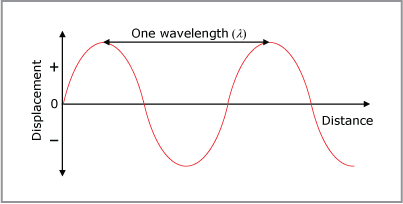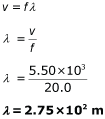Characteristics of mechanical waves
Waves have common characteristics whether they are mechanical or electromagnetic. The following are characteristics of mechanical waves.
This refers to the change in position of a particle from its mean position.
The unit for displacement is the metre (m).
This is the maximum displacement of a particle from its mean position.
View how amplitude is related to wave energy.

Amplitude is a measure of the wave's energy; the greater the amplitude, the greater the wave energy. The unit for amplitude is the metre (m).
Wavelength (symbol  ) is the distance between two consecutive particles that are undergoing the same motion. The unit for wavelength is the metre (m). A prefix is often used if the size of the wavelength is very small or quite large, eg μm or km.
) is the distance between two consecutive particles that are undergoing the same motion. The unit for wavelength is the metre (m). A prefix is often used if the size of the wavelength is very small or quite large, eg μm or km.

Frequency (symbol f) is the number of waves passing a given point every second. The unit for frequency is the hertz (Hz). One hertz is equal to one wave per second.
This is the time required for a particle to complete one wave cycle.
The symbol for the period is T and the unit is the second (s).
The relationship between the period and the frequency of a wave is defined as follows.

The speed of a wave is the speed at which the energy is travelling through the medium. It is defined in the following way.
Speed = frequency × wavelength or v = f
This is often referred to as the wave equation.
The speed of mechanical waves varies according to the:
- state of matter (whether it is a solid, liquid or gas)
- density
- temperature
- elasticity of the medium.
The table below displays the speed of sound (a form of mechanical wave) for various media. Do you notice any trends?
| Medium | Speed (m s-1) | Medium | Speed (m s-1) |
|---|---|---|---|
| Rubber | 6 × 101 | Oak | 4.0-4.4 × 103 |
| Carbon dioxide gas | 2.65 × 102 | Steel | 4.7-5.2 × 103 |
| Air | 3.40 × 102 | Soda glass | 5.0-5.3 × 103 |
| Hydrogen gas | 1.30 × 103 | Aluminium | 5.10 × 103 |
| Fresh water | 1.41 × 103 | Pine | 3.3 × 105 |
| Sea water | 1.54 × 103 | Brass | 3.65 × 105 |

A transverse seismic wave from a minor earthquake has a frequency of 20.0 Hz. The speed of this wave is 5.50 × 103 m s-1 in granite. Calculate the wavelength of this wave in granite.



Wavelength of ocean waves
The speed of ocean waves depends on several factors. The most important being the depth (d) of ocean through which the wave is moving and the wavelength ( ) of the wave.
) of the wave.
For shallow ocean depths (where d <  /20) the speed of an ideal mechanical wave can be calculated using the equation v = √(gd).
/20) the speed of an ideal mechanical wave can be calculated using the equation v = √(gd).
In addition, the speed of the wave is also v = f .
.
Carry out the following steps:
1. Use a stopwatch to measure the period of the waves.
2. Estimate a depth (in metres) for the shallow water.
3. Calculate the speed of the waves using v = √(gd).
4. Calculate the wavelength of the waves using v = f .
.

Examine ocean waves approaching and breaking on a beach.

Answer the following questions relating to the above video.
1 |
Describe the amplitude of the ocean waves near the shore compared to further out to sea. The amplitude near the shore is: |
2 |
Describe the wavelength of the ocean waves near the shore compared to further out to sea. The wavelength near the shore is: |
3 |
Describe the speed of the ocean waves near the shore compared to further out to sea. The speed near the shore is: |
4 |
Describe the frequency of the ocean waves near the shore compared to further out to sea. The frequency near the shore is: |

You may wish to consider the following as a group.
- If the speed of a wave changes so too does the wavelength but the frequency will always be constant. Discuss.
- The speed of mechanical waves generally increases in media with higher density. Explain.
- If energy passes through a medium of stacked foam balls will the energy appear as a wave in this medium? Explain.
- Soon after the beginning of the universe, the medium created was extremely dense. Is it likely there were sound waves and if so, would they have been moving quickly?





